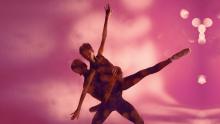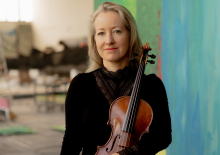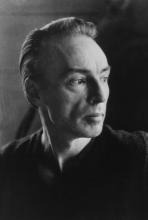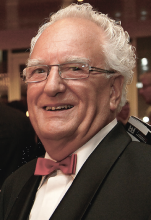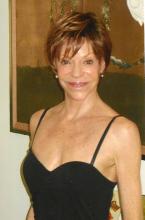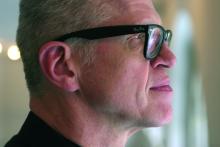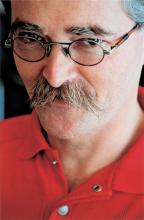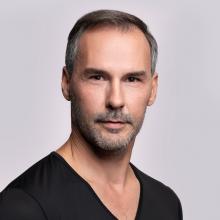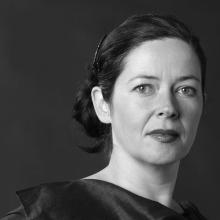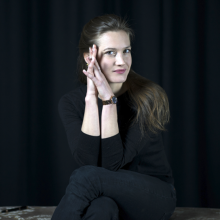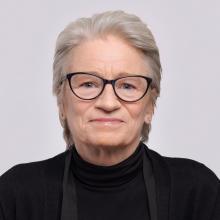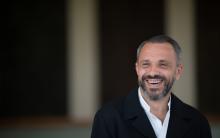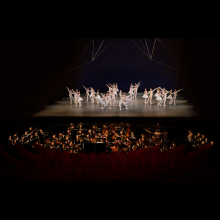Manoeuvre
The changing view of masculinity
In 2012, former soloist Juanjo Arqués swapped performing on stage for making a living as a freelance choreographer. Since then, the Spaniard has regularly created works not just for Dutch National Ballet and its Junior Company, but also for numerous prominent companies abroad. He created Manoeuvre, his most recent work for Dutch National Ballet, at the beginning of 2020, but the world premiere had to be postponed due to the corona pandemic. And when the ballet did premiere later that year, the theatres had to close again after just one performance. So after that, Manoeuvre has only been presented online, up to now.
Manoeuvre is inspired by Arqués’ thoughts about masculinity, particularly about how views of the concept of masculinity are changing in our Western society. Whereas masculinity has often traditionally been associated – and in many countries still is – with being strong, acting powerfully and showing leadership, in our Western society this view is shifting, slowly but surely. Arqués says this creates more scope for men’s emotional life, and men who demonstrate sensitivity and express their emotions can count on more appreciation.
Arqués chose to set his ballet for seven men to Shaker Loops by John Adams. The composer transformed the effects of wave motion into music, which is also reflected in the S-shaped set designs by Tatyana van Walsum. Adams’ composition has often been used before by choreographers – including Hans van Manen – but Arqués has always known that one day he’d like to give his own interpretation of it. Arqués says, “It’s a piece of music that has everything; music that gives you plenty of possibilities for exploring the concept of masculinity. On the one hand it’s hugely powerful and confrontational, but on the other it has sections that are softer, more lyrical and more natural.”
He uses this contrast to the full in Manoeuvre, so the piece is not only composed of ensemble sections with angular shapes, taut lines, clenched fists and stylised brawls, but also gives scope to the individual and thus to feelings of fear, uncertainty, desire and intimacy. Although initially the emotions still seem to be suppressed – represented, for example, by a hand over the mouth – the atmosphere gradually becomes more playful and open, and there is increasing opportunity for sensitivity and freedom.
Yet Arqués does not want to tell a story or convey a message through Manoeuvre. He says the ballet is an abstract reflection of a change he perceives in our society, but ultimately it is up to each member of the audience to interpret it for themselves.
Frank Bridge Variations
Unity in contrasts
Frank Bridge Variations was the first work that Hans van Manen created for Dutch National Ballet after returning to the company in January 2005 as resident choreographer, a position he had held previously from 1973 to 1987. The ballet is based on the composition Variations on a Theme of Frank Bridge by Benjamin Britten (1913-1976), who wrote the piece as a tribute to his teacher Frank Bridge. The composition for string orchestra, which brought international recognition to Britten, consists of eleven virtuoso, distinctive and sometimes parodying variations on a theme taken by the English composer from Bridge’s string quartet Three Idylls. Van Manen used nine of the eleven variations (he found the others too romantic) for his ballet, in which the music inspired him to indulge in contrasts: sharp and flowing, precise and free, hot-tempered and melancholic. But however diverse they might be, together the sections of the piece form a unity that is as logical as it is amazing, and in which even the most familiar Van Manen characteristics acquire a new sheen.
The ballet begins with a powerful opening scene for the five couples, who are dressed in simple burgundy and bronze-coloured unitards. Two soloist couples then break free from the ensemble. The first couple’s duets are dominated by a suppressed tension. Despite the slow movements Van Manen created to the Adagio and the Chant, the dancing is charged with energy. The second couple’s duets, danced to the Wiener Walzer and at the end of the ballet, are lighter in tone and pervaded by tenderness and sensuality. In between the soloist duets, the two male soloists steal the show with two energetic solos: one full of pride and swagger to the March, and the other as frenzied as the raging fury of the Moto Perpetuo.
Van Manen is not a ‘vague, long-winded choreographer’, as he once succinctly formulated it. On the contrary, he aims to have the least possible ballast, so that things are as essential and manageable as they can be. This is why the structure of his movement compositions always demonstrates such clarity and refined simplicity. And this certainly applies to his Frank Bridge Variations, in which he succeeds in creating maximum expression – often through the simplest of steps. A good example is the Funeral March, where the ensemble advances slowly across the stage, generating an unparalleled effect that exudes an indefinable threat; a feeling that is reinforced by the refined designs by Keso Dekker and lighting by Bert Dalhuysen.
Van Manen’s Frank Bridge Variations was described by the press as ‘hitting the mark’. One of the critics wrote, “The ballet is fascinating from start to finish (..) and so musical that it seems as if Van Manen’s danced interpretation of Benjamin Britten’s nine miniatures is the only correct one”.
The Four Temperaments
Gloomy, cheerful, imperturbable and hot-headed
The Four Temperaments is one of the early works by the Russian-American choreographer George Balanchine (1904-1983). Besides being a key work in his oeuvre, it was also the first Balanchine ballet to be taken into Dutch National Ballet’s repertoire, in 1961. It is hard to believe it has now been around for over 75 years. The ingenious, tricky choreography that frequently crackles with energy still adds a magical dimension to Hindemith’s composition of the same name.
Balanchine created The Four Temperaments in 1946 for the opening programme of Ballet Society, the forerunner of New York City Ballet. Although the work does not tell a story, it does have a theme. As the title suggests, the ballet – like Hindemith’s music – is inspired by the Ancient Greek classification of character traits into four main types: melancholic, sanguinic, phlegmatic and choleric. Balanchine gives an abstract and subtle rendition of these ‘temperaments’ just by adding differences to the way energy is discharged in the dancing. The ballet is also a clear example of how this most important dance innovator of the twentieth century revitalised the age-old aesthetic traditions of ballet by injecting them with the dynamic vitality and swinging high spirits of American jazz dance and showdance.
One of Balanchine’s most famous quotes is “Ballet is woman”, and although there are also some wonderful male roles in The Four Temperaments, the women do predominate. With their high leg extensions and pronounced hip movements, they keep rising to the surface like long-legged ‘insects’.
The opening section of the ballet, Theme, consists of three short duets, which are contemplative, fiery and lyrical in turn. This is followed by Melancholic, the first of the four temperaments, interpreted by a male soloist who is joined first by two female dancers and then by another four. The gloominess of this character is expressed by the way the dancer appears to be pulled towards the ground. Then follows the cheerfulness of Sanguinic, in flowing, energetic dance patterns for a soloist couple and four female dancers. In Phlegmatic, the imperturbability is expressed by the languid and polished interplay of lines through which a male soloist and a quartet of female dancers demonstrate Balanchine’s characteristic intertwining movements. The last temperament is Choleric. Impatience and hot-headedness are portrayed here in a dazzling, explosive variation for a female soloist. She is soon joined by the other dancers, and a grand finale follows – featuring protracted high lifts – in which all the themes are briefly re-introduced as if to underline that different temperaments can go together very well, even within one person.
Texts: Astrid van Leeuwen
